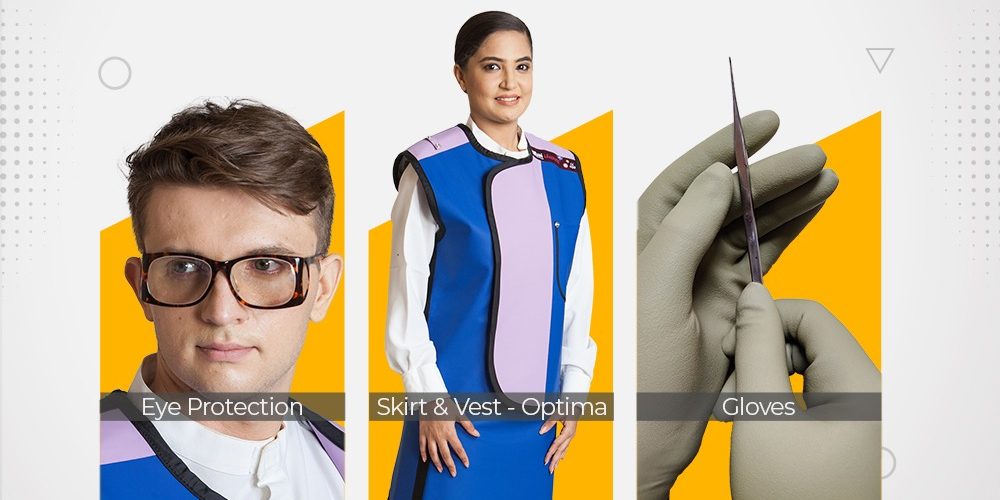Introduction
Exposure to X-rays not only causes damage to the skin but also increases the risk of developing cancer. Shielding the body with radioprotective accessories and radiation protection aprons is very much important. Radiation protection aprons protect healthcare practitioners against radiation from X-ray fluoroscopy and other harmful radiation beams emitted by medical imaging devices during surgery or conducting a test.
Physicians who perform interventional procedures are more likely to get exposed to radiation and they must protect their bodies by wearing radiation protection aprons, radiation protection gloves, thyroid collars, protective headwear, and radiation protection glasses.
Full body protection is recommended to reduce the effects of exposure to ionizing radiation while working in any imaging environment. Wearing proper radiation protection clothes and using radiation protection devices can reduce the scattered dose received by the physician.
Importance of Wearing Radiation Protection Aprons and Accessories:
A radiation protection apron provides protection from radiation and acts as a radiation shield and they are mostly used in the radiology department and operating suites. It is very much important that one must protect themselves from both front and backscatter that are created from all scattering objects by wearing proper shielding accessories. It is most important that one must wear a radiation protection garment that fits properly at the neckline and armhole so that the breast or chest area is not exposed to radiation. It is very important to use well-fitting radiation protection aprons and thyroid shields, eyewear, and gloves to ensure proper safety from harmful medical rays. To know more about radiation protection accessories visit radiation protection.
Equivalent Shielding is required to protect the body from Radiation Beams
At least 0.50 mm of lead equivalent shielding is required to protect the body part from the direct harmful radiation beam.
Shelf Life of Radiation Protection Aprons
Radiation protection aprons must be changed immediately even one notices a hole, tear or crack in the apron. The life expectancy of an apron is 2-3 years and defects start to appear after regular usage.
The shielding material can suffer from damage due to long-term usage like cracks and holes, which are not visible. Hence, one must check their radiation protective garments and devices after every 3 months to determine the degree of damage.
Regular Screening is Important to Check for Defects
The aprons are used to protect the healthcare practitioners and patients from radiation exposure and it is designed in such a way to shield the body from harmful radiation. To know more about a huge range of radiation protection aprons and devices visit radiation protection.
People who regularly wear radiation protection aprons or other similar radiation protection devices must visually inspect these devices prior to each use to check for obvious signs of damage like tears or cracking of the radio protection material present inside.
Lightweight and Comfortable Aprons
Sometimes long-term use of heavy radiation protective garments can use fatigue and musculoskeletal problems in interventional physicians. Many radiologists, interventional doctors, and cardiologists indicate a relationship between the use of radioactive protective aprons and spine problems. A standard traditional apron can weigh up to more than 7 kg, which may develop back problems.
Trivitron has launched Lightweight Radiation Protection Aprons made from lighter-weight radioprotective materials like antimony and bismuth and the apron is build following the nanoparticle technology. This apron is 10% lighter than a standard traditional apron and has a radioactive equivalent weight effect just similar to a traditional apron. For more information visit Double Sided Apron – Maxima
These aprons are best for performing long-duration surgeries and are very comfortable to wear without compromising the health of the medical professional.
Ways to Check for Damage Caused to Radiation Protection Aprons
- Physical test
- Touch test
- Visual test
- Tactile test- In this test fluoroscopic images can be taken to check for holes or changes in uniformity.
The most common site of damage is the waist of the apron and also the lower part of the apron. Devices like radioactive gloves, thyroid shields, eyewear, must be regularly inspected for damage.
Ways to Increase the Shelf Life of Radiation Protection Aprons
The radiation protection aprons must be hung on special hangers and one must not fold the aprons as they can develop cracks. If hangers are not available then the best choice is to store them flat, which is not as good as handing but better compared to folding the apron.
Hence one must always hang their apron carefully when it is not in use. To know more about hanging devices visit Mobile Storage System with Hangers.
Radiation Safety Awareness is a Must
Radiation safety education and awareness are very much important to protect the patients and medical staff. Due to the revolution in modern diagnostic and fluoroscopy for diagnosis and treatment, it is important to follow all the guidelines and measures that can help to decrease radiation exposure in doctors, radiologists, and patients to ensure their optimum safety.
Protective devices that are used inappropriately and if not properly taken care of can increase the risk of radiation exposure. There must be regular annual inspections, to check for personal protective equipment maintenance and efficacy to protect the body from even small direct or indirect radiation rays.

